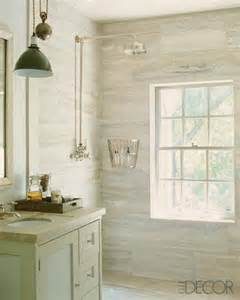Inviting, accommodating and a feast for the eyes—wet rooms are showing up in more and more homes and wowing visitors at new-home showcases.
Wet rooms—essentially open-concept or barrier-free bathrooms—are tiled continuously from floor to ceiling and across the floor surface, giving a sleek, unified appearance.
The shower is open to the room or enclosed in clear glass, and has no raised threshold to step over. Sinks, countertops and vanities mounted to the walls hover above the unbroken plane of the floor.
The wet room’s uninterrupted sight lines give a feeling of space to even a relatively small room. The continuous floor surface makes for easy cleanup and allows people in wheelchairs or with restricted mobility to move freely.
Here are a few things to consider when designing your wet room:
Express Yourself
The open spaces and abundance of tile that define a wet room invite you to splash on your own creative look. Whether you choose soothing earth tones and textures, cool minimalist grays, whites and blacks, or whimsical colors and patterns, the wet room creates an eye-catching display.
spaces and abundance of tile that define a wet room invite you to splash on your own creative look. Whether you choose soothing earth tones and textures, cool minimalist grays, whites and blacks, or whimsical colors and patterns, the wet room creates an eye-catching display.
Curbless Shower
Because the entire room is waterproof, your curbless shower also can be completely open to the room, with no enclosure at all. Just be sure there’s enough space to place the toilet and sink where they won’t get splashed by spray from the shower.
Glass enclosures with seamless glass doors are another popular option. They’ll contain water on all sides without impeding the view.
Or sometimes simply a slab partition between the shower and the toilet will do the trick, leaving the front of the shower open to the rest of the room. The slab may be a foot or two short of the ceiling and face the doorway to minimize its effect on the visual flow.
Threshold drains—or grates that are flush with the tile floor—may define the edge of the shower area without interrupting the floor’s flow. Some drains even glow from within, using interior colored or white LED lighting for an extra flair and to help orient a person under the shower’s spray.
Another popular option is adding a place to sit in the shower. A built-in slate ledge, matching or contrasting with the wall tile, a wall-mounted drop-down bench in bamboo or a free-standing teak stool is a handy feature for anyone and contributes to the overall design.
Fixtures
Floating vanities, attached to the wall without legs, and floating countertops look great with today’s vessel sinks and minimalist faucets.
In addition to their sleek look, these features also provide sink access for anyone in a wheel chair. Drawers or shelves attached underneath or on each side of the sink provide storage.
Professional Installation
To be sure your wet room keeps the water where it’s supposed to be, it’s important that everything be installed just right, and that might require a professional.
Floor grading is key—constructed to slope gently and almost imperceptibly, but effectively, toward drains. Tile must be properly installed and sealed to prevent leaks.
Once it’s done right, your wet room will be easy to use, to clean and to enjoy—a lovely oasis in your home.
To find a contractor or remodeler to help you create your wet room, visit www.RochesterHomeBuilders.com – your industry professionals.
Recent Comments